For the 2025 school year, there are 2 public elementary schools serving 740 students in Montesano School District. This district's average elementary testing ranking is 8/10, which is in the top 30% of public elementary schools in Washington.
Public Elementary Schools in Montesano School District have an average math proficiency score of 53% (versus the Washington public elementary school average of 41%), and reading proficiency score of 52% (versus the 51% statewide average).
Minority enrollment is 25% of the student body (majority Hispanic), which is less than the Washington public elementary school average of 52% (majority Hispanic).
Overview
This School District
This State (WA)
# Schools
3 Schools
1,833 Schools
# Students
1,442 Students
740,174 Students
# Teachers
82 Teachers
44,879 Teachers
Student : Teacher Ratio
18:1
18:1
District Rank
Montesano School District, which is ranked within the top 30% of all 306 school districts in Washington (based off of combined math and reading proficiency testing data) for the 2021-2022 school year.
The school district's graduation rate of 85-89% has decreased from 90-94% over five school years.
Overall District Rank
#77 out of 307 school districts
(Top 30%)
(Top 30%)
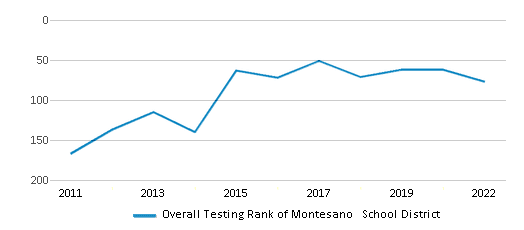
Math Test Scores (% Proficient)
43%
40%
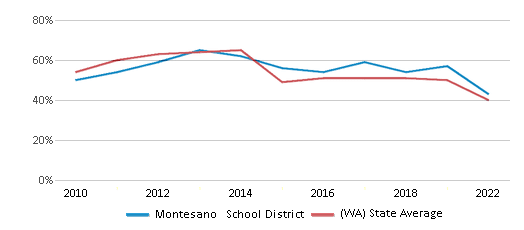
Reading/Language Arts Test Scores (% Proficient)
55%
53%
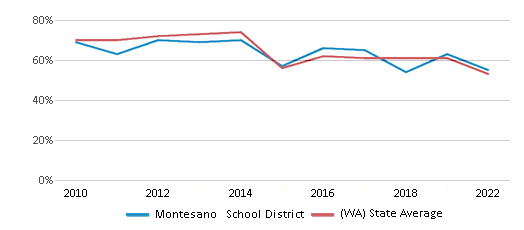
Science Test Scores (% Proficient)
42%
49%
Graduation Rate
85-89%
84%
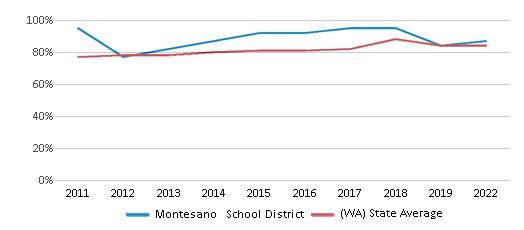
Students by Ethnicity:
Diversity Score
0.40
0.69
# American Indian Students
22 Students
9,834 Students
% American Indian Students
2%
1%
# Asian Students
23 Students
66,765 Students
% Asian Students
2%
9%
# Hispanic Students
166 Students
187,960 Students
% Hispanic Students
12%
26%
# Black Students
6 Students
34,994 Students
% Black Students
n/a
5%
# White Students
1,101 Students
353,967 Students
% White Students
76%
48%
# Hawaiian Students
5 Students
11,000 Students
% Hawaiian Students
n/a
2%
# Two or more races Students
118 Students
67,620 Students
% of Two or more races Students
8%
9%
Students by Grade:
# Students in PK Grade:
8
15,322
# Students in K Grade:
146
74,525
# Students in 1st Grade:
85
77,872
# Students in 2nd Grade:
117
81,806
# Students in 3rd Grade:
97
78,256
# Students in 4th Grade:
86
81,082
# Students in 5th Grade:
98
81,722
# Students in 6th Grade:
103
80,515
# Students in 7th Grade:
123
73,171
# Students in 8th Grade:
126
72,324
# Students in 9th Grade:
109
5,537
# Students in 10th Grade:
117
5,680
# Students in 11th Grade:
118
5,765
# Students in 12th Grade:
109
6,597
# Ungraded Students:
-
-
District Revenue and Spending
The revenue/student of $14,517 in this school district is less than the state median of $18,796. The school district revenue/student has stayed relatively flat over four school years.
The school district's spending/student of $14,340 is less than the state median of $19,246. The school district spending/student has stayed relatively flat over four school years.
Total Revenue
$21 MM
$20,715 MM
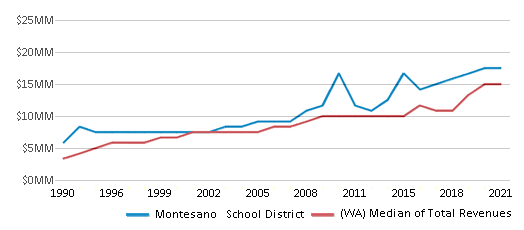
Spending
$21 MM
$21,212 MM
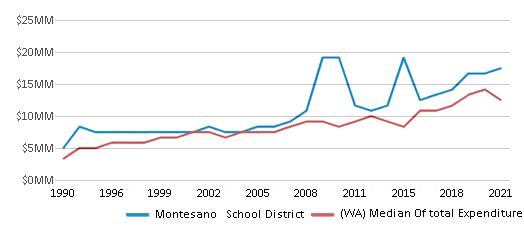
Revenue / Student
$14,517
$18,796

Spending / Student
$14,340
$19,246
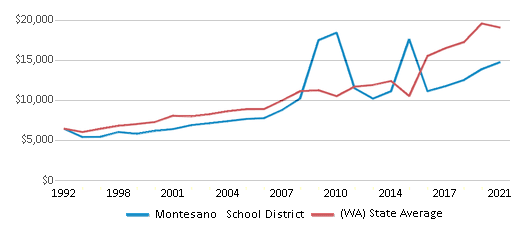
Best Montesano School District Public Elementary Schools (2025)
School
(Math and Reading Proficiency)
(Math and Reading Proficiency)
Location
Grades
Students
Rank: #11.
Beacon Avenue Elementary School
(Math: 65-69% | Reading: 60-64% )
Rank:
Rank:
8/
Top 30%10
1717 East Beacon Avenue
Montesano, WA 98563
(360) 249-4528
Montesano, WA 98563
(360) 249-4528
Grades: PK-2
| 356 students
Rank: #22.
Simpson Avenue Elementary School
(Math: 53% | Reading: 52%)
Rank:
Rank:
7/
Top 50%10
519 West Simpson Avenue
Montesano, WA 98563
(360) 249-4041
Montesano, WA 98563
(360) 249-4041
Grades: 3-6
| 384 students
Recent Articles

Year-Round Or Traditional Schedule?
Which is more appropriate for your child? A year-round attendance schedule or traditional schedule? We look at the pros and cons.

Why You Should Encourage Your Child to Join a Sports Team
Participating in team sports has a great many benefits for children, there is no doubt. In this article you will learn what those benefits are.

White Students are Now the Minority in U.S. Public Schools
Increasing birth rates among immigrant families from Asia and Central and South America, combined with lower birth rates among white families, means that for the first time in history, public school students in the United States are majority-minority. This shift in demographics poses difficulties for schools as they work to accommodate children of varying language abilities and socio-economic backgrounds.





